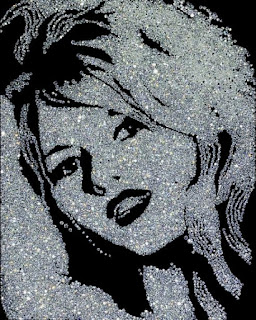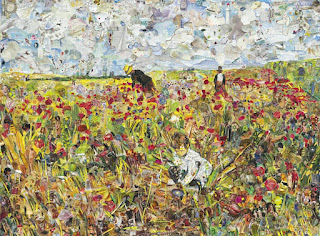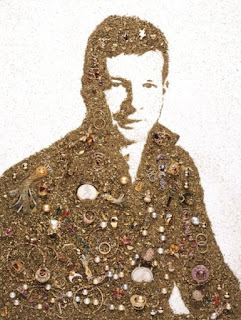Vik Muniz (Portuguese pronunciation: [ˈvik muˈnis]; born 1961, in São Paulo, Brazil)[1] is a Brazilian artist and photographer. Initially a sculptor, Muniz grew interested with the photographic representations of his work, eventually focusing completely on photography. Primarily working with unconventional materials such as tomato sauce, diamonds, magazine clippings, chocolate syrup, dust, dirt, etc., Muniz creates works of art and then photographs them.[2] His work has been met with both commercial success and critical acclaim, and has been exhibited worldwide.
In 2010, Muniz was featured in the documentary film Waste Land. Directed by Lucy Walker, the film highlights Muniz's work on one of the world's largest garbage dumps, Jardim Gramacho, on the outskirts of Rio de Janeiro. The film was nominated to the Academy Award for Best Documentary Feature at the 83rd Academy Awards.[3][4]
Contents
Early life[edit]
Vik Muniz was born in 1961 in São Paulo, Brazil, as the only child of Maria Celeste, a telephone operator, and Vincente Muniz, a restaurant waiter.[5] Muniz’s grandmother, Ana Rocha, taught him how to read at an early age. In his memoir, Muniz recalled struggling with writing in school which is why he turned to visuals to communicate his thoughts.[6] At the age of 14, his math teacher recommended him to enter an art contest. He won and was awarded a partial scholarship to an art studio.[7][6]
Career[edit]
Early career[edit]
At the age of 18, Muniz got his first job working in the advertising industry in Brazil, redesigning billboards for higher readability.[8] While on the way to his first black-tie gala, Muniz witnessed and attempted to break up a street fight, where he was accidentally shot in the leg by one of the brawlers. He was paid by the shooter to not press charges and used the money to travel to Chicago in 1983. In Chicago, Muniz worked at a local supermarket cleaning the parking lot while he attended night school to study English. In the English class, he learned Polish, Italian, Spanish, and Korean without any improvements to his English vocabulary. Later, Muniz attended culinary and carpentry classes where he learned most his of English.[8]
Muniz took his first trip to New York in 1984. There, he visited the Museum of Modern Arts and met a woman who changed his thoughts on Jackson Pollock’s paintings. This also influenced Muniz to move to New York just two months after his first visit.[8] Muniz's friend lent him a studio where he started his career as a sculptor. He was 28 when he had his first solo exhibit in 1989.[6]
Influences and technique[edit]
Inspired by works of Man Ray and Max Ernst, Muniz executes simple imagery intricately.[9] Marshall McLuhan’s Understanding Media encouraged Muniz to explore perception in the media through abstraction and manipulating the components of the image.[8] He cites the mosaics in a church in Ravenna as one of his influences and is also a self-proclaimed student of Buster Keaton.[10] He decided to become an artist after seeing the works of the Postmodernists Cindy Sherman and Jeff Koons.[7] Muniz, like both of these artists, reworks popular imagery in his work. Muniz says that he does not believe in originals, but rather believes in individuality.[10] Muniz works to re-purpose themes and showcase them in a different light for the viewer.[2]
Muniz is best known for recreating famous imagery from art history and pop culture with unexpected, everyday objects, and photographing them. For example, Muniz's Action Photo, After Hans Namuth (From Pictures of Chocolate), a Cibachrome print, is a Bosco Chocolate Syrup recreation of one of Hans Namuth's photographs of Jackson Pollock in his studio. The monumental series Pictures of Cars (after Ruscha) is his social commentary of the car culture of Los Angeles utilizing Ed Ruscha's 60's Pop masterpieces rendered from car ephemera. Muniz often works on a large scale and then he destroys the originals of his work and only the photo of his work remains.[10]
Muniz has spoken of wanting to make "color pictures that talked about color and also talked about the practical simplification of such impossible concepts." He also has an interest in making pictures that "reveal their process and material structure," and describes himself as having been "a willing bystander in the middle of the shootout between structuralist and post-structuralist critique."
Muniz says that when he takes photographs, he intuitively searches for "a vantage point that would make the picture identical to the ones in my head before I’d made the works," so that his photographs match those mental images. He sees photography as having "freed painting from its responsibility to depict the world as fact."
In Muniz's earthworks series, Pictures of Earthworks, show a strong resemblance to the 1970s Earthworks movement. However unlike the Earthworks movement, that were influenced by ancient cultures, Muniz's series shows distinct human impact on nature.[11]
Political and social themes[edit]
In addition to sculpting, Muniz experiments with drawing and photography, which is seen in the series Sugar Children, featured in the Museum of Modern Art's New Photography 13 show, alongside Rineke Dijikstra, An-My Le, and Kunié Sugiura, in 1997. In Sugar Children, Muniz photographed the families that worked on sugar plantations on the Caribbean island of St. Kitts. Beginning with Polaroids of several of the children of plantation workers, Muniz "drew" the images by sprinkling sugar on black paper and rephotographed these compositions. This series was met with criticism, where scholars have pointed out that he photographs of subjects continuing to live in poverty and yet can make upwards of 5 figures on these works at auction.[7]
After his Pictures in Garbage series, Muniz donated the profits, close to $50,000, from the Marat (Sebastiao) to the workers collective after it was auctioned in the UK. He also tries to make art more accessible through the use of common materials, because of his belief that the art world should not be just for the elite.[12] Muniz stated in the documentary Waste Land, "I'm at this point in my career where I'm trying to step away from the realm of fine arts because I think it's a very exclusive, very restrictive place to be. What I want to be able to do is to change the lives of people with the same materials they deal with every day."


























































































































































































































































































No comments:
Post a Comment